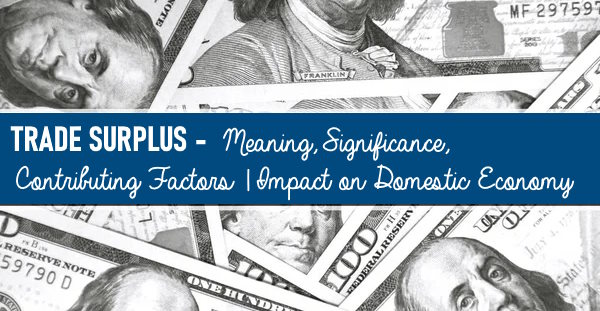Trade Surplus | Meaning | Significance | Contributing Factors | Impact on Domestic Economy
Table of Contents
What is Trade Surplus?
Trade surplus refers to a positive balance of trade where a country’s total exports of goods and services exceed its total imports. In other words, the value of a country’s exports is greater than the value of its imports. This results in a surplus of foreign currency, as the exporting country is receiving more foreign currency in exchange for its goods and services than it is paying out for imports.
A trade surplus can be seen as a measure of a country’s economic strength and competitiveness in the global market, as it indicates that the country is producing goods and services that are in demand by other countries, and that it has a strong export industry relative to its imports.

Significance of Trade Surplus
Trade surplus has significant economic and political implications for a country. Here are some of the most important:
Economic Growth
A trade surplus can lead to economic growth as it indicates that a country is exporting more goods and services than it is importing. This can create jobs, increase productivity, and stimulate economic activity.
Boost in Foreign Currency Reserves
Trade surplus leads to an increase in foreign currency reserves as the country receives payments in foreign currencies from other countries. These reserves can be used for various purposes such as investments, debt repayment, and foreign aid.
Lowering National Debt
Trade surplus can be used to pay off national debt, which can reduce interest payments and free up resources for other government programs.
Geopolitical Influence
A trade surplus can provide a country with geopolitical influence as it can use its economic power and leverage to influence other countries.
Currency Appreciation
A sustained trade surplus can lead to the appreciation of the country’s currency, which can make imports cheaper and exports more expensive. This can create inflation and affect the country’s overall competitiveness.
Trade Tensions
Trade surplus can also lead to trade tensions with other countries, especially if they feel that they are being unfairly disadvantaged by the surplus.
Technological Advancement
To maintain and improve its competitiveness, a country with a trade surplus may invest in research and development to create new and innovative products that can be exported to other countries.
Consumer Benefits
Trade surplus can benefit consumers as it can result in lower prices for domestic goods, higher quality products, and increased variety.
Trade Policy
A trade surplus can influence a country’s trade policy, including negotiations with other countries, tariff rates, and import regulations. The surplus may encourage the country to protect domestic industries and increase trade barriers to maintain its position in the international market.
Factors Contributing to a Trade Surplus
Several factors can contribute to a trade surplus, including:
Comparative Advantage
A country that has a comparative advantage in producing a particular good or service can produce that good or service at a lower cost than other countries. This means that the country can sell its products to other countries at a lower price and still make a profit. As a result, other countries may be willing to import these products, which can increase the country’s exports and generate a trade surplus.
High Quality of Goods
Exporting more goods and services than it imports results in a trade surplus for a country. By producing high-quality goods, a country can increase its exports and hence, improve its trade surplus. The production of high-quality goods can enable a country to meet global demand and make its products more attractive to international buyers. Thus, a country’s ability to maintain a trade surplus largely depends on its production and export capabilities.
Low Production Costs
Low production costs can lead to a trade surplus because they enable a country to sell its products at a lower price than other countries. This makes the country’s products more competitive in the global market, which can increase demand for those products and lead to an increase in exports. As a result, the country can generate a trade surplus by exporting more than it imports. Additionally, low production costs can also lead to increased investment and job creation, which can further boost the country’s economy.
Strong Export Industry
A strong and diversified export industry can help a country to increase its exports, leading to a trade surplus.
Favorable Exchange Rates
If a country’s currency is weak relative to other countries, its exports become cheaper, leading to an increase in exports and a trade surplus.
Government Policies
Government policies such as export subsidies, tax incentives, and investment in infrastructure can boost exports and contribute to a trade surplus.
Reduced Imports
A reduction in imports can lead to a trade surplus as the country is relying more on domestic production to meet demand.
Intellectual Property
A country that is a leader in developing and owning intellectual property rights (IPRs) can earn significant revenues from licensing or selling them, leading to a trade surplus.
Infrastructure
A country with robust infrastructure, including transportation networks, communication systems, and logistics, can better facilitate the movement of goods and services, leading to increased exports and a trade surplus.
Growing Domestic Market
A growing domestic market can lead to increased production and economies of scale, making the country’s goods and services more competitive globally and leading to a trade surplus.
A trade surplus can result from a combination of factors, including a strong export industry, favorable exchange rates, low production costs, and supportive government policies. A country that achieves a trade surplus can benefit from increased employment, economic growth, and higher foreign currency reserves.
Impact of a Trade Surplus on the Domestic Economy
A trade surplus can have various impacts on a country’s domestic economy, including:
Employment
A trade surplus can lead to increased employment in related industries, such as manufacturing and transportation, as higher demand for exports creates jobs.
Economic Growth
Economic growth can impact trade surplus in several ways. Firstly, a growing economy typically leads to increased demand for goods and services, which can increase a country’s exports and generate a trade surplus. Secondly, economic growth can lead to increased investment, which can increase a country’s production capacity and make it more competitive in the global market. This, in turn, can increase exports and generate a trade surplus.
However, rapid economic growth can also lead to increased demand for imports, which can lead to a trade deficit. Therefore, managing the balance between exports and imports is crucial to maintaining a trade surplus and promoting sustainable economic growth. Finally, economic growth can also lead to changes in exchange rates, which can impact a country’s trade balance.
Increased Investment
A trade surplus can attract foreign investment as other countries may see the surplus as a sign of economic strength and stability.
Currency Appreciation
A sustained trade surplus can lead to currency appreciation, which can make imports cheaper and exports more expensive. This can make the country’s exports less competitive and reduce the surplus over time.
Inflation
A trade surplus can also lead to inflation if increased demand for exports leads to increased production costs, which may be passed onto consumers.
Overreliance on Exports
A country with a trade surplus may become overly reliant on its export industry, which can leave it vulnerable to changes in global demand or trade policies.
Increased Income Inequality
A trade surplus can increase income inequality if the benefits of the surplus are not distributed evenly among the population.
Current Account Balance
A trade surplus contributes to a country’s current account surplus, which indicates that the country is earning more from exports than it is spending on imports. This can improve the overall balance of payments, making the country more attractive to foreign investors.
Fiscal Policy
A trade surplus can provide a government with additional revenue through taxes on exports, which can be used to fund government programs or pay down debt.
Industry Specialization
A trade surplus can encourage a country to specialize in industries where it has a comparative advantage, which can lead to greater efficiency and innovation over time. This can make the country’s exports more competitive and contribute to long-term economic growth.
A trade surplus can have both positive and negative impacts on a country’s domestic economy. It can lead to increased employment, economic growth, and investment, but it can also cause currency appreciation, inflation, and overreliance on exports. Therefore, policymakers should carefully monitor the impacts of trade surplus on the domestic economy and take measures to mitigate any negative effects.
Examples of countries with trade surplus
There are several countries in the world that currently have a trade surplus, here are a few examples:
China
China has been running a trade surplus for many years, with exports of manufactured goods, such as electronics, machinery, and textiles, being a major contributor to the surplus.
Germany
Germany is known for its strong export-oriented economy, with a focus on high-value manufacturing and engineering. The country has consistently maintained a trade surplus over the years.
Japan
Japan is a major exporter of electronics, automobiles, and machinery, which have contributed to the country’s long-standing trade surplus.
Netherlands
The Netherlands is a small country but has one of the largest trade surpluses in the world, largely due to its exports of machinery, chemicals, and transport equipment.
South Korea
South Korea’s economy is heavily dependent on exports of electronics, automobiles, and petrochemicals, which have contributed to its trade surplus.
Switzerland
Switzerland has a long history of maintaining a trade surplus, largely due to its strong financial sector and exports of high-end luxury goods, such as watches, jewelry, and pharmaceuticals.
Taiwan
Taiwan is a major producer of electronics and computer components, which account for a significant portion of the country’s exports and trade surplus.
Singapore
Singapore’s economy is heavily dependent on exports of electronics, pharmaceuticals, and refined petroleum, which have contributed to its trade surplus.
Norway
Norway is a major exporter of oil and gas, which make up a significant portion of the country’s exports and contribute to its trade surplus.
Sweden
Sweden’s economy is dominated by exports of high-tech manufacturing goods, such as telecommunications equipment, machinery, and vehicles, which have contributed to the country’s trade surplus.
These countries represent a diverse range of industries and economies, but they all have one thing in common: a strong focus on exports and a competitive advantage in their respective industries. However, as mentioned earlier, a trade surplus is not always an indication of a healthy economy and can have both positive and negative impacts on a country’s domestic economy.


